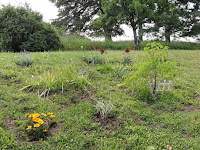 |
| Ken's backyard whimsical village |
Ken
called two weeks ago Monday as he prepared for an extended trip. “I’ll get
Mike,” I said. (The two of them visit frequently.)
“No,”
said Ken, “I called to talk to you.” The raspberries in his back yard were
ripening quickly, he said, and should be picked while he was away. Was I
interested?
So
I agreed that I would pick the berries whenever I could. He would also invite a
neighbor to pick, he said.
 |
| The Kingdom of McKim |
Ken
left Wednesday. Thursday my phone rang. (Yes, I actually heard it and answered.)
It was Ken, calling from New York, about to leave for Vermont. “I picked three
quarts of raspberries Tuesday night,” he said, “so they should be ready again
tomorrow.”
“What
about the neighbor?” I asked. Efforts to contact the neighbor were
unsuccessful, he said. The berries were all mine. “WooHoo! Yes!” I thought.
Aloud I said, “Sure, I’ll pick. Don’t worry about it.”
 Of
course, I feel badly for the efforts Ken has put into this patch only to miss
berry season. I’ve consistently picked two to three pints every other day or so,
putting most of the berries in the freezer. But at the last picking, many of
the berries were over-ripe, so today I decided to make raspberry jam.
Of
course, I feel badly for the efforts Ken has put into this patch only to miss
berry season. I’ve consistently picked two to three pints every other day or so,
putting most of the berries in the freezer. But at the last picking, many of
the berries were over-ripe, so today I decided to make raspberry jam.
Both
my parents were jelly makers. Mother was particular and stressed that the recipe
must be followed to a “t” to ensure success. I guess my dad thought that rules
were made to be broken because he took liberties and success was not quite so
certain. Okay, to be frank, I’m more sloppy with my measuring than Mother would
like, but more obedient to the rules than my dad. I’ve had some failures, but only
when I tried to cook jelly without pectin. In other words, I know where I went
wrong.
 So,
here I am in town making raspberry jam on a hot day. I would have eliminated the seeds and
made jelly, but my food mill and canning kettle are on the farm, so freezer jam
it is, complete with seeds. I didn’t like the idea of not cooking the berries
and the sugar, as per the instructions for freezer jam, so I retrieved my new
stockpot from the storage shed and cooked it. In the years when I didn’t have a
canning kettle, Mother would always say, “Just put it in the freezer,” so
that’s what I did. KW
So,
here I am in town making raspberry jam on a hot day. I would have eliminated the seeds and
made jelly, but my food mill and canning kettle are on the farm, so freezer jam
it is, complete with seeds. I didn’t like the idea of not cooking the berries
and the sugar, as per the instructions for freezer jam, so I retrieved my new
stockpot from the storage shed and cooked it. In the years when I didn’t have a
canning kettle, Mother would always say, “Just put it in the freezer,” so
that’s what I did. KW
[Monday evening (June 27), I opened the slider for Bess and observed an eerie scene -- a thunderstorm in the making, the setting sun reflected on the clouds.]
















